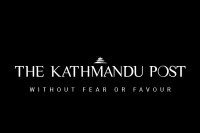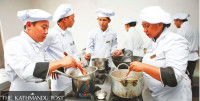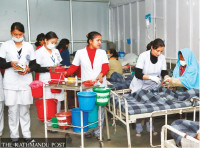Miscellaneous
Lord’s is Lord’s
For a career sports journalist, who has followed the ups and downs of Nepali cricket for a decade, watching Nepal play at Lord’s was itself a big achievement.
A majority of the national team cricketers had their own version of defining England’s Lord’s Cricket Ground before their appearance at world cricket’s historic stadium in a July 19 match against Marylebone Cricket Club (MCC). For a career sports journalist, who has followed the ups and downs of Nepali cricket for a decade, watching Nepal play at Lord’s was itself a big achievement. And Lord’s being Lord’s, needless to say; the experience was out of this world.
My first distinct memory of Lord’s is back from 2002 when former Indian skipper Saurav Ganguly took off his shirt and waved it in celebration as India chased down a target of 327 in an ODI final. For a gentleman’s game—played at the home of cricket—Ganguly was later accused of bringing the game to disrepute (Lord’s still strictly enforces a highly-formal dress code). But being a fan of Indian cricket, I had no qualms. Ganguly’s shirt-waving would etch the image of Lord’s, and its Victorian pavilion, deep into my mind.
Which is why, I was more anxious than excited when I landed in London, four days before the game. Nepal had a practice match before they took on MCC but, in truth, it seemed all were desperate for the wait to be over soon. For the cricketers (and sports journalists alike) playing at Lord’s would be an extraordinary experience. Those four days would be the longest wait of our lives.
Then the match-day finally arrived. In the morning I along with two fellow journalists made our way to Golder’s Green, before making the 15-minute drive to Lord’s. The ground itself is located on an unsuspecting St John’s Wood Street, which, in its normal exhibition, rarely gives an impression that the street has preserved a vital part of sports history. Once at the ground, we verified our accreditation and entered the hallowed ‘home of cricket’. All sorts of dreams were coming true at the same time.
History was now right in front of our eyes and the first thing that drew our attention was the JP Morgan Media Centre which has remained a major attraction in recent years. As we approached the media centre, we were, understandably, spellbound by its design. Commissioned for a cool £5 million during the 1999 World Cup, the media centre was designed with boat-building technology and is only accessible via two elevator shafts that support the structure.
The wait was over. We entered the media centre, which just two days earlier was packed with scribes from England and Pakistan reporting the first Test between the two countries. The centre—which stands 15 metres above the ground—offers a magnificent view of the lush grounds, the entire stadium and the majestic Victorian-era pavilion that has housed all of the cricketing greats—from Donald Bradman and Garry Sobers to Brian Lara and Sachin Tendulkar.
For a moment, I took myself back to Nepal and regretted not having such facility at home. Let alone a state-of-the-art media centre, the Tribhuvan University (TU) ground is often sarcastically called a ‘paddy field’ by many who know Nepali cricket. Standing at Lord’s made me realise the huge gap our country needs to fill if it is to truly rub
shoulders with the world’s cricketing heavyweights.
But, Lord’s that day was just TU in disguise. The streets outside the stadium were reverberating to the tune of Nepali musical instruments, even though instruments (and general hullabaloo) are barred from entering the grounds as per Lord’s rules and regulation. The otherwise calm and disciplined Lord’s was cackling with the excited cheer of the 5000 Nepali supporters who cheered every ball delivered and every run scored. When I spoke to the Nepali skipper Paras Khadka after he led Nepal to a historic victory that day, he said: “It almost felt like playing at our own home.” Khadka took pride in the fact that his side has been garnering support across the world. Wherever Nepal plays, it becomes a home away from home.
Lord’s is also a shining example of how centuries-old discipline and tradition can be preserved. Before we left for the grounds, we were informed that the MCC would be hosting a reception for both the teams at the Members’ Bar in the pavilion. Learning that the entry into the bar would require a suit including a tie, we had ourselves prepared. But to my horror, I had forgotten my tie. We still tried to get in but were stopped by an elderly enforcer who said, matter-of-factly, “How can you get in? You don’t have a tie.”
We regretted having taken the tradition lightly and waited outside the bar before finally being allowed access. The pavilion is rich in history, and houses an iconic museum (the world’s first sports museum) that boasts an impressive collection which includes the revered Ashes urn. The team dressing rooms are adorned with honour boards which mark every century made in a Test match on the grounds and all instances of a bowler taking five wickets in an innings or 10 wickets in the match. You will find the names of all the who-is-who of cricketing history etched on the walls.
The one-day experience at the Lord’s cannot be defined in words. After the reception, I walked to the grounds outside the pavilion and gazed in disbelief at the media centre. Right above me was the same balcony where Ganguly infamously broke decorum and waved his shirt. My mind took me back to the time when I was preparing for my SLC exams.
At the time, when I returned home after playing a cricket match, I found that my father had dumped all of my text books outside our home. He was furious that I had picked cricket over the optional mathematics exams, due the next day. For me, it has always been only cricket.
With time, I decided to give up on playing cricket and looked for other ways to remain in touch with the game. It is why I became a sports journalist. During the early days of my career, my family constantly asked me to change my profession. “What will sports journalism give you?” I was often asked, without being able to reply at the time.
Now, I found the answer at Lord’s.




 22.23°C Kathmandu
22.23°C Kathmandu









